
Hello friends. You’ve heard of books written based on a celebrity’s experience? How about one based on the life of her parent? Years ago, Madge Walls wrote a contemporary novel, Paying the Price, which I loved. So, when she contacted a group of her Colorado friends to announce she’d written another book, this one a historical, I invited her to tell us about it. I’ve already started The Visiting Girl; it’s nothing short of amazing. Please welcome Author Madge Walls to Help from My Friends Friday. ~ Donnell
Hidden Historical Gems Anchor a Story in Reality
by Madge Walls
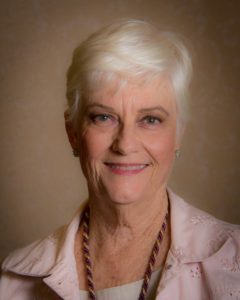
Author Madge Walls
I’m often asked where I get the ideas for my novels. Once it was a real estate deal on Maui that went spectacularly bad. Once it was an offhanded remark my brother made at our father’s funeral. My latest, The Visiting Girl, came by way of a beat-up paperback biography of movie star Katharine Hepburn. The story of her mother, also named Kate, fired my creative juices. Her story was tragic, heartfelt, and astounding.
I was struck by the struggle of the elder Kate, who, as an orphaned teenager in the 1890s, hired an attorney to force her guardian uncle to allow her to enroll at Bryn Mawr College, one of the earliest U.S. colleges for women, founded in 1885. Kate’s late mother left a legacy for this very purpose, but her uncle, typical of the time, scorned the idea of higher education for women. Kate won the desperate fight, then had to buckle down to conquer Bryn Mawr’s overwhelming entrance requirements. Upon graduation she was out of funds and at distressingly loose ends.
With no immediate family, not raised to work, and no husband in sight, the real-life Kate’s became a “visiting girl,” going from home to home among her married friends in Philadelphia. Her visiting days ended when she met and married the up-and-coming Dr. Thomas Hepburn, gave birth to an eventual movie star, and became a leader in the women’s suffrage movement. That was all the prompt I needed. My next novel bloomed in my head and wouldn’t leave me alone until I sat down to write it.
For my own visiting girl, Lily Paxton, the visiting circuit soon pales. Lily disappears, leaving her best friend Caroline a note saying she is off to an adventure out West. Lily keeps to herself that she is three months pregnant and has left with a man she barely knows—a man who is not the baby’s father.
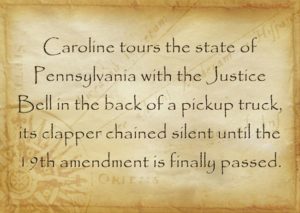 Twenty years later, Lily writes to Caroline from Portland, Oregon, where she is dying of leukemia, asking Caroline to come to her in her final days. Caroline leaps at the opportunity to reconcile with her long-lost friend, but soon discovers that Lily has a hidden agenda that threatens to destroy both their families.
Twenty years later, Lily writes to Caroline from Portland, Oregon, where she is dying of leukemia, asking Caroline to come to her in her final days. Caroline leaps at the opportunity to reconcile with her long-lost friend, but soon discovers that Lily has a hidden agenda that threatens to destroy both their families.
Upon finishing the first draft, I realized that the 20-year timeframe, dictated by my characters’ attendance dates at Bryn Mawr, encompassed the landmark events of the day: the Great War, Prohibition, the Spanish Flu pandemic, and of course the fight for women’s suffrage. I’d carefully researched leukemia, train rides and Pullman porters, and the neglectful care of premature infants at the time. But how had I gotten to “The End” without my characters’ lives being affected by these four world-shaking crises?
Back to page one! I dug deep and came to a reasonable understanding of those historic events, then wove Lily’s and Caroline’s stories through them. Not just verifying facts, and no need to give boring history lessons—a terrible idea in a novel. What thrilled me was discovering many unexpected historical gems that anchored the story in the early twentieth century—things I could never have made up.
Caroline, for example, marches in the notorious Fourth Liberty Loan Parade in Philadelphia, a huge success in selling bonds to finance the Great War, but, along with thousands of other marchers and onlookers, brings home the dreaded Spanish Flu. Once recovered, Caroline tours the state of Pennsylvania with the Justice Bell in the back of a pickup truck, its clapper chained silent until the 19th amendment is finally passed. Who knew?
Lily, in Portland, runs a tea shop that becomes a gathering place for Oregon suffragists of all stripes and hosts speaker Abigail Scott Duniway, a tireless leader of the cause in Oregon, a woman I’d never heard of!
While the Portland police chief and the mayor are in cahoots running a bootlegging ring (more news to me), Lily’s florist husband Marco buys “vine flowers” from his suppliers that happen to arrive in corked bottles instead of vases for their dinner table. These gems, hiding in plain sight once I began noticing them, give color and richness to the story. Brief, authentic sketches, you might say, that evoke the era in the reader’s mind.
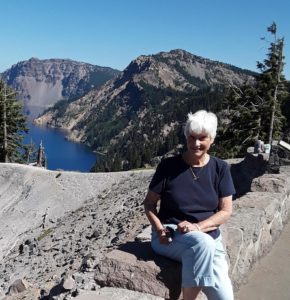
The Author at Crater Lake in Oregon
What I’ve learned is not to be overwhelmed by research. I write the bones of the story first to make sure it holds together (a rich first draft—I hate outlining—too many memories of hated high school and college term papers). Then I go back and fill in or verify the historical details, using books, websites, and personal interviews. Each gem found within the larger research plants the story more vividly in the reader’s imagination and keeps her turning the pages. It keeps me going, too, feeling ever so clever about my accidental finds and fitting them into the story.
 About the Book: The Visiting Girl a historical novel of friendship, loyalty, secrets, and romance set in Philadelphia and Portland, Oregon, in the early 1900s. A mystery? Yes, but not in the traditional sense.
About the Book: The Visiting Girl a historical novel of friendship, loyalty, secrets, and romance set in Philadelphia and Portland, Oregon, in the early 1900s. A mystery? Yes, but not in the traditional sense.
The Cover: My talented daughter-in-law and professional designer, Heather Walls, created the cover. When at first all the glowing feedback was about the cover, I began to fear that nobody was reading the text. Then I realize that not everybody spends as many hours a day reading other people’s books as I do. Give them time, I hastily reminded myself. That time was duly rewarded, as with the review below.
My favorite Amazon review: “The Visiting Girl is an absolute delight to read! Evenly paced and lively, fluid, and full of descriptions that paint beautiful and colorful scenes. Far more than simply a narrative of a woman’s life experience, Walls skillfully weaves threads of feminist history at the turn of the 20th century, various political issues, and Oregon’s history into the narrative. If only American history had been taught to me through novels when I was in high school and college! –A Verified Purchaser
Available on Amazon.com: The Visiting Girl
About the Author: Madge Walls was raised in Honolulu and raised her three children on Maui. She attended University of Oregon Honors College, majoring in mathematics with lots of literature courses thrown in, then spent six years as a computer programmer in the Canadian oil industry.
Moving back to the Islands in 1971, she wrote freelance feature articles for the Maui News and became a Realtor and real estate instructor. Her first two novels, Paying the Price and Buyers Are Liars, reflect the crazy ups and downs of her real estate career in an island state that was once a monarchy.
Relocating to Colorado in 2001 to be closer to her sons and their families, she worked as a freelance indexer of nonfiction books. This opened her eyes to an important but underappreciated detail of the publishing industry and taught her a great deal about writing styles and book structure.
She currently lives in Southern Oregon, where she enjoys reading, writing, traveling, hula dancing, and all the wonders of outdoor life in the Pacific Northwest.
Visit the author’s website: Madge Walls Books


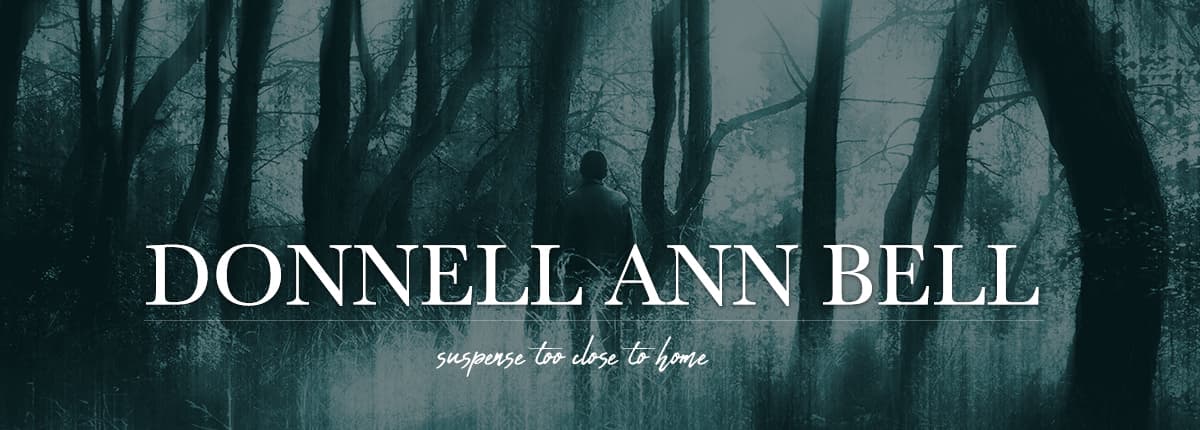
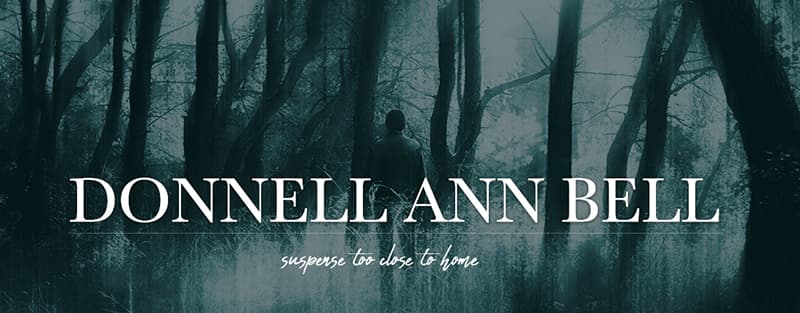







Love your book premise and I will add the cover is very nice, too. Good luck!
Fascinating story about “visiting girls.” I had no idea they even existed. Good luck with the novel.
Madge, so delighted you’re my guest today. The details in your book put me back in this era. I was there. You use phrasing popular in the day, and one in particular I’ve never heard before. To give you some context, you write, “Arrived on their doorstep unannounced. At first they were bricks about it. I’ve never heard that saying. Had you until you wrote this book?
I will put this on my list of books to read. Sounds intriguing.
Excellent post! Great meeting you, Madge!
Just reading the summary of your journey and how you came to write this book is a cogent reminder of how far women have come in the last one hundred or so years. It sounds fascinating. Good luck with your writing.
What a fascinating sounding novel! I’m off to get my copy.
Your writing journey and how you wrote your book was fascinating. Aren’t we lucky we had such persistent suffragettes? I, also, remember how much I hated outlining in my classes. I liked your way of writing.
Thank you all for your gracious comments about “The Visiting Girl.” I learned way more than I expected about women’s lives in the early 1900s. It was fun creating Lily and Caroline, who showed a great deal of spunk, each in her own way! We haven’t won final victory yet, so
We the Women need to keep pushing until we are truly equal under the law and out from under the thumbs that still want to keep us down. That said, the best years of my life were my years as a full time homemaker, shepherding my three sons to responsible adulthood. Choices!!!
Lovely to meet you all, and I look forward to exploring your novels!
Madge
Donnell, you asked about my use of the phrase, “…they were bricks about it.” I remember very clearly when I first heard that. When I was 14, my best friend’s father died very unexpectedly at home. Kathy was an only child, and her mother wanted her out of the house while she dealt with it. They brought Kathy to me and told me to keep her company. What did I know about these things? We sat on my bed, both of us in total shock, not daring to speak about it. Later my mother, in reference to Kathy’s composure, said to me, “Boy, that Kathy. She was a real brick about Louie’s death.” It struck me as such an odd thing to say. She had completely misread the situation. I had no doubt that the tears would come later. BTW, Kathy and I play Words With Friends, her in CA and me in OR!
Replying to Susan Oleksiw, the term “visiting girl” came from Barbara Leaming’s “Katharine Hepburn,” my main source and inspiration for The Visiting Girl. I searched the Internet and did not find it anywhere, so I assume Ms. Leaming coined the term. I gave her full credit in my Acknowledgements. Today such a person might be known as a high class couch surfer!!
Your writing process is similar to my own. I look forward to reading about the first Kate Hepburn. The premise of the book hooked me before the synopsis.
I like how you let the gems you spotted in the research touch your story and affect its development. Sounds fantastic.
What a great story to pursue!